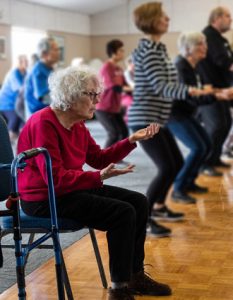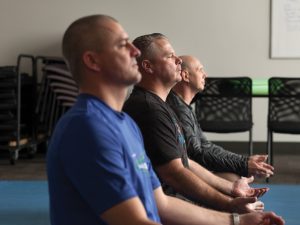Some Mild Unpleasant Events Occur as a Result of Mindfulness-Based Programs
By John M. de Castro, Ph.D.
“Potential side effects are often front and center when considering taking medicine for physical or mental conditions, but information is less clear with treatments like meditation that don’t come in pill form.” – Marianne Spoon
People begin meditation with the misconception that meditation will help them escape from their problems. Nothing could be further from the truth. In fact, meditation does the exact opposite, forcing the meditator to confront their issues. In meditation, the practitioner tries to quiet the mind. But, in that relaxed quiet state, powerful, highly emotionally charged thoughts and memories are likely to emerge. The strength here is that meditation is a wonderful occasion to begin to deal with these issues. But often the thoughts or memories are overwhelming. At times, professional therapeutic intervention may be needed.
Many practitioners never experience these negative experiences or only experience very mild states. There are, however, few systematic studies of the extent of negative experiences. In general, the research has reported that unwanted (negative) experiences are quite common with meditators, but for the most part, are short-lived and mild. There is, however, a great need for more research into the nature of the experiences that occur during meditation.
In today’s Research News article “Frequency of Self-reported Unpleasant Events and Harm in a Mindfulness-Based Program in Two General Population Samples.” (See summary below or view the full text of the study at: https://www.ncbi.nlm.nih.gov/pmc/articles/PMC7920887/ ) Baer and colleagues recruited teachers who were participating in a study of an 8-week mindfulness training in schools and undergraduate and graduate students enrolled in an 8-week group-based mindfulness courses. The participants completed online measures of anxiety and depression and questions about difficult experiences during or after the mindfulness training including difficult thoughts, emotions, and sensations.
They found that 77% of the teachers reported never or occasionally having unpleasant experiences while 22% reported having unpleasant experiences more often. Of those who had unpleasant experiences 88% reported they were not at all or somewhat upsetting while 12% reported them to be quite a bit or extremely upsetting. The unpleasant experiences reported were “difficult emotions, cognitions, or sensations such as frustration, anxiety, distressing thoughts or memories, bodily pain or discomfort, and sleepiness.”
The 61% of the students reported never or occasionally having unpleasant experiences while 39% reported having unpleasant experiences more often. Of those who had unpleasant experiences 92% reported they were not at all or somewhat upsetting while 8% reported them to be quite a bit or extremely upsetting. The unpleasant experiences reported “involved difficult thoughts, emotions, and physical sensations; others described recognition of personal patterns” and guilt about not practicing enough.
These results suggest that the unpleasant experiences occurring during and after mindfulness training are common but generally mild. The experiences are most often the same as those expected by mindfulness teachers. These experiences are to some extent the goal of mindfulness training to increase awareness of one’s own internal experiences and these can be sometimes upsetting. In rare instances, the experiences are quite upsetting and this is to be expected as some people will discover things about themselves that are difficult to deal with.
Psychological therapies in general are designed to uncover and deal with unpleasant thoughts, memories, emotions etc. It is thus not surprising the this is true also of mindfulness training. This suggests that mindfulness teachers, like other therapists, have to be sensitive to these unpleasant experiences in their students and be prepared to deal with extremely difficult experiences.
So, some mild unpleasant events occur as a result of mindfulness-based programs.
“It’s really important to know the prevalence of people who are having adverse reactions.” – Matt Hirschberg
CMCS – Center for Mindfulness and Contemplative Studies
This and other Contemplative Studies posts are also available on Google+ https://plus.google.com/106784388191201299496/posts and on Twitter @MindfulResearch
Study Summary
Baer, R., Crane, C., Montero-Marin, J., Phillips, A., Taylor, L., Tickell, A., Kuyken, W., & MYRIAD team (2021). Frequency of Self-reported Unpleasant Events and Harm in a Mindfulness-Based Program in Two General Population Samples. Mindfulness, 12(3), 763–774. https://doi.org/10.1007/s12671-020-01547-8
Abstract
Objectives
Evidence-based mindfulness programs have well-established benefits, but the potential for harmful effects is understudied. We explored the frequency and severity of unpleasant experiences and harm in two nonclinical samples participating in an adaptation of mindfulness-based cognitive therapy (MBCT) for the general population.
Methods
Study 1 included 84 schoolteachers; study 2 included 74 university students. Both studies were uncontrolled. Participants completed self-report questionnaires about psychological symptoms before and after the 8-week mindfulness course. After the course, they responded to a survey designed for this study that included Likert ratings and free-text questions about unpleasant experiences and harm. All data were collected online.
Results
In both samples, about two-thirds of participants reported unpleasant experiences associated with mindfulness practice during the course. Most participants (85–92%) rated these experiences as not at all or somewhat upsetting; some indicated that difficult experiences led to important learning or were beneficial in some way. The proportion of participants reporting harm from the mindfulness course ranged from 3 to 7%. The proportion showing reliable deterioration on symptom questionnaires ranged from 2 to 7%. Those reporting harm and those showing reliable deterioration on questionnaires were largely separate subgroups; only one participant fell in both.
Conclusions
Findings highlight the need for mindfulness teachers to manage expectations about benefits and difficulties that may occur in mindfulness-based programs and to work skilfully with participants experiencing difficulties. Experiences of harm may not be captured by symptom questionnaires and should be explicitly assessed in other ways.
https://www.ncbi.nlm.nih.gov/pmc/articles/PMC7920887/









